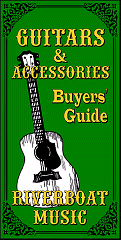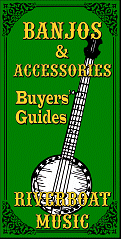


|
Mandolin for Guitarists
In this age of "cheats" and "hacks," I could have called this "Mandolin Hacks (or Cheats) for Guitarists," but then people would click on the article title thinking there was some magic shortcut to learning a new instrument with a 200-year-old tradition. There isn't really.
But there are some things that helped me adjust to mandolin for those times when a mandolin is handy and there are already too many guitars and banjos playing along.
And mandolin is fun to play. I seldom play it during, say, solo gigs. But during a Folk jam or such when everyone else seems to be playing guitar, it's great to add another layer of bright tone to the mix. And it's a lot easier to take, say, backpacking, than a Dreadnought.
Adjustments You Would Need to Make:
- Mandolins are tuned in 5ths (like violins), so chords and scales are different. There's a simple trick for learning the new cords, though - that's shown below.
- Mandolin necks are tiny, with small nut widths and frets that are very close together. It can take a bit of time to get used to, but I know folks with fingers like sausages who can play them, so don't let that drive you away.
- Mandolin strings are tuned in pairs. So I might call the most common tuning pattern GDAE (from your chin down), but other folks might call it GGDDAAEE. As a 12 string player, adjusting to mandolin's double string pattern never bothered me a bit - I was surprised that so many other folks had issues with it. Once you get used to treating each pair of strings as a single string, any difficulty there seems to subside.
- Many guitarists coming to the mandolin for the first time complain that they're harder on the left hand, even for folks whose fingertip callouses could drive a nail. Remember that Bluegrass players of all instruments use medium strings, and many mandolins come so equipped. Adjusting the action and using light strings can help. But I can't help thinking that at least part of it is that your left hand fingertips are coming to the strings at a different angle than they do on guitar, so the pressure points are different enough that you notice.
All of those issues considered, I know of many guitarists who added mandolin to their arsenal of skills without too much trouble once they took time to practice. Most folks recommend books and lessons, even if you're already accomplished on other instruments.
A Short Cut to Learning Mandolin Chords - Strings on the mandolin are exactly backwards from the lowest four strings on your guitar.
That means that if you want to play chords, you can figure out some chords just by turning the lowest four strings of your guitar around in your head.
Here are some examples. If it's easier just to memorize the chords, that's fine. And there are better ways to play the chords we show, once you advance to that level. But if you haven't gone there and somebody hands you a mandolin in the middle of a jam session, this trick will get you started.
 Let's start with G, a very popular chord in Folk, Country, and Bluegrass. On guitar, you typically fret the lowest two strings. You leave the next two strings open. For this exercise, we'll ignore the highest two strings on the guitar. Picture the guitar's G cord backwards (. Ignoring the highest two strings). That gives you the G chord on your mandolin. Let's start with G, a very popular chord in Folk, Country, and Bluegrass. On guitar, you typically fret the lowest two strings. You leave the next two strings open. For this exercise, we'll ignore the highest two strings on the guitar. Picture the guitar's G cord backwards (. Ignoring the highest two strings). That gives you the G chord on your mandolin.
By the way, this is a perfect mandolin chord, because there is a G in the bass and a D (the fifth) above that. Since so many Bluegrass songs are pitched in G, this is a chord you're likely to use forever.
 A chord that usually shows up in the key of G is C. Using the same approach, ignore the top two strings on the guitar, turn the lower four strings around in your head. The good part of this C chord is that you can go back and forth between G and C quickly just by moving your fingers a string over. The bad part is that the tonic (C) doesn't show up in the lower octave. So if you are playing a song in the key of C, you won't have the "foundation" you might expect. A chord that usually shows up in the key of G is C. Using the same approach, ignore the top two strings on the guitar, turn the lower four strings around in your head. The good part of this C chord is that you can go back and forth between G and C quickly just by moving your fingers a string over. The bad part is that the tonic (C) doesn't show up in the lower octave. So if you are playing a song in the key of C, you won't have the "foundation" you might expect.
That's why we show an alternative fingering for the C chord.

The D chord that you make using this technique is perfect as is (though many mandolin pickers use a different fingering).
The tonic (D) sits over the fifth (A), and the F# is the highest note, like it is on guitar (only an octave higher).
The A chord as shown is, shall we say, interesting?  The easy version doesn't have a third, so it could substitute for A major or A minor. Again, if you're in, say the key of D, and you hop over to A, this chord will substitute fine. The easy version doesn't have a third, so it could substitute for A major or A minor. Again, if you're in, say the key of D, and you hop over to A, this chord will substitute fine.
If you're playing a song in A, however, you should probably consider adding the major third (C#) just to have a fuller sound. That's what the "better" example on the chart does.
 The E and Em chords both work as you would expect them to. But the third is in the bottom of the chord. The E and Em chords both work as you would expect them to. But the third is in the bottom of the chord.
For many songs, it will sound better if you don't stress that note too much. If the song is in A, fine. If it's in the key of E (or Em), you might consider choosing another fingering.
Related Articles
- About Mandolins- An overview of mandolin history, including musical styles and tuning conventions.
- "Mandolin Buyers' Guide" - To keep from filling my reference pages with product ads and recommendations, I set up an entirely separate site (RiverBoatMusic.com) for listing products that are worth considering from vendors who are reasonably trustworthy. The Mandolin "Buyers' Guide" is here.
- For information about other music collections and projects, check the links at the bottom of this page.
 Whatever else you get out of our pages, I hope you come away with some great ideas for "sharing the joy." Whatever else you get out of our pages, I hope you come away with some great ideas for "sharing the joy."
And please stay in touch!
- Paul Race









All material, illustrations, and content of this web site is copyrighted (c) 2001, 2002, 2003, 2004, 2005, 2006,
2007, 2008, 2009, 2010, 2011, 2012, 2013, 2014, 2015, 2016, 2017, 2018, 2019, 2020, 2021, 2022 by Paul D. Race. All rights reserved.
Creek Dont' RiseTM is a participant in the Amazon Services LLC Associates Program, an affiliate advertising
program designed to provide a means for sites to earn advertising fees by advertising and linking to Amazon.com.
For questions, comments, suggestions, trouble reports, etc. about this page or this site, please
contact us.
| Visit related pages and affiliated sites: |
| - Music - |

|
 |
 |

|

|

|

|

|

|

|

|

|

|

|

|

|

|

|
| - Trains and Hobbies - |

|

|

|  |
 |

|
| - Christmas Memories and Collectibles - |
 |

|
 |

|
 |

|
| - Family Activities and Crafts - |
 |

|

|

|

|

|
|

















































